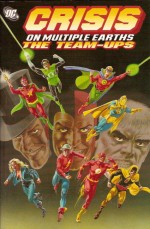
By Gardner Fox, John Broome & various (DC Comics)
ISBN: 978-1-4012-0470-9
As I’ve mentioned before, I was one of the “Baby Boomer” crowd that grew up with Gardner Fox and John Broome’s tantalisingly slow reintroduction of Golden Age superheroes during the halcyon, eternally summery days of the 1960s. To me those fascinating counterpart crusaders from Earth-Two weren’t vague and distant memories rubber-stamped by parents or older brothers – they were cool, fascinating and enigmatically new. And for some reason the “proper” heroes of Earth-One held them in high regard and treated them with obvious deference…
It all began, naturally enough, in The Flash, flagship title of the Silver Age Revolution. After ushering in the triumphant return of the costumed superhero concept the Scarlet Speedster, with Fox and Broome at the reins, set an unbelievably high standard for superhero adventure in sharp, witty tales of science and imagination, illustrated with captivating style and clean simplicity by Carmine Infantino.
Gardner Fox didn’t write many Flash scripts at this time, but those few he did were all dynamite. None more so than the full-length epic that literally changed the scope of American comics forever. ‘Flash of Two Worlds’ (the Flash #123 September 1961, illustrated by Infantino and Joe Giella) introduced the theory of alternate Earths to the continuity and by extension resulted in the multiversal structure of the DCU, Crisis on Infinite Earths and all the succeeding cosmos-shaking crossover sagas that grew from it. And of course where DC led, others followed…
During a benefit gig Flash (police scientist Barry Allen) accidentally slips into another dimension where he finds that the comic-book hero he based his own superhero identity upon actually exists. Every adventure he had absorbed as an eager child was grim reality to Jay Garrick and his mystery-men comrades on the controversially named Earth-2. Locating his idol Barry convinces the elder to come out of retirement just as three Golden Age villains, Shade, Thinker and the Fiddler make their own wicked comeback… Thus is history made and above all else, ‘Flash of Two Worlds’ is still a great read that can electrify today’s reader.
Fox revisited Earth-2 nine months later in #129’s ‘Double Danger on Earth!’ (inked by Murphy Anderson) as Jay Garrick ventured to Earth-1 to save his own world from a doom comet, only to fall foul of Captain Cold and the Trickster. Another cracking thriller, as well as double Flash action, this tale teasingly reintroduced Justice Society stalwarts Wonder Woman, Atom, Hawkman, Green Lantern, Doctor Mid-Nite and Black Canary. Clearly Editor Schwartz had something in mind…
‘Vengeance of the Immortal Villain!’ from Flash #137 (June 1963, inked by Giella) was the third incredible Earth-2 crossover, and saw the two Flashes unite to defeat 50,000 year old Vandal Savage and save the Justice Society of America: a tale which directly led into the veteran team’s first meeting with the Justice League of America and the start of all those aforementioned “Crisis” epics.
That landmark epic can be found elsewhere (most notably in Crisis on Multiple Earths volume 1, ISBN-13: 978-1-56389-895-2), and this collection continues with the less well-known ‘Invader from the Dark Dimension!’ (Flash #151, March 1964, by Fox, Infantino and Giella), a full-length shocker where the demonic Shade ambitiously attempts to plunder both worlds.
Public approval was decidedly vocal and Editor Julie Schwartz used DC’s try-out magazines to sound out the next step: stories set on Earth-2 with exclusively Golden Age characters.
Showcase #55 saw the initial team-up of Doctor Fate and Hourman as the Justice Society stalwarts battled the monster of Slaughter Swamp when ‘Solomon Grundy Goes on a Rampage!’ Produced by Fox and Anderson, this bombastic yarn even had room for a cameo by Earth-2’s Green Lantern, and the original text page featuring the heroes’ origins is also reproduced here.
Showcase #56 also featured “the Super-Team Supreme” (and by the same creative team supreme) in ‘Perils of the Psycho-Pirate!’ wherein ex-con Roger Hayden (cell-mate of the original JSA villain) steals the magical Masks of Medusa to go on an emotion-controlling crime-spree. Fan-historians should note that this tale is a pivotal antecedent of the landmark Crisis on Infinite Earths (ISBN: 978-1-5638-9750-4) as well as a superbly engaging adventure in its own right. A text feature on the original Psycho-Pirate accompanies the story.
Although getting in late to the Counterpart Collaborations game, the inevitable first teaming of the Hal Jordan and Alan Scott Green Lanterns is one of the best and arguably second-most important story of the entire decade. ‘Secret Origin of the Guardians!’ by John Broome, Gil Kane and Sid Greene (Green Lantern #40, October 1965) introduced the renegade Guardian Krona, revealed the origin of the multiverse, showed how evil entered our universe and described how the immortal Oans took up their self-appointed task of policing the cosmos. It also shows Gil Kane’s paramount ability to stage a superhero fight like no other. This pure comicbook perfection should be considered a prologue to the aforementioned Crisis on Infinite Earths.
Still looking for an Earth-2 concept that would support its own series Schwartz, Fox and Anderson debuted the team of Starman and Black Canary in The Brave and the Bold #61 (September-October 1965), pairing the heroes against the eerily translucent villain the Mist in ‘Mastermind of Menaces!’ This compelling thriller is augmented here by the text feature biography of the Black Canary.
Although not featured in this volume, Schwartz and Fox did finally achieve their ambition to launch a Golden Age hero into his own title. After three Showcase appearances and many guest-shots the Spectre won his own book at the end of 1967, just as the super-hero craze went into a steep decline.
This fabulous volume concludes with a back-up tale from issue #7 (November/December 1968) of that brilliant but ill-fated series. ‘The Hour Hourman Died!’ by Fox, Dick Dillin and Sid Greene, is a dark and clever attempted-murder mystery that packs a book’s worth of tension and action into its nine moody pages and serves as a solid thematic reminder that the golden Silver Age of the 1960s was a creative high point that simply couldn’t last. When you start at the top the only way is down…
Still irresistible and compellingly beautiful after all these years, the stories collected here shaped the American comics industry for decades and are still influencing not only today’s funny-books but also the brilliant animated TV shows and movies that grew from them. These are tales and this is a book you simply must have.
© 1961, 1962, 1963, 1964, 1965, 1968, 2005 DC Comics. All rights reserved.

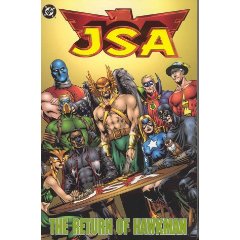
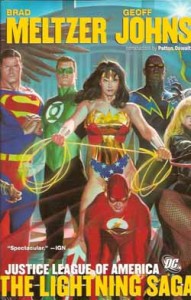
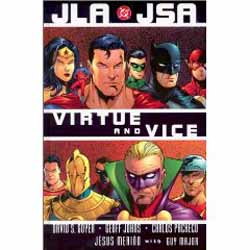
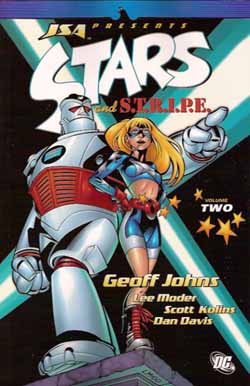
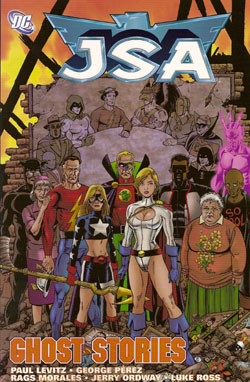
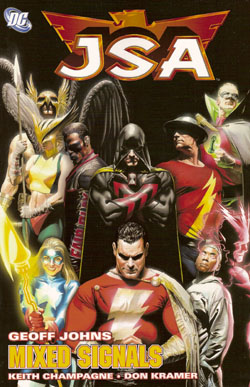
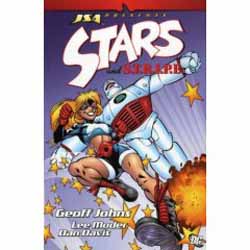
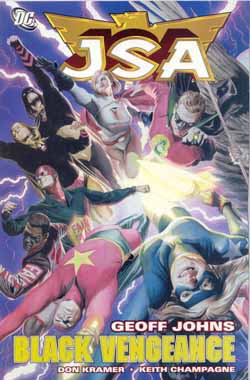 Â
 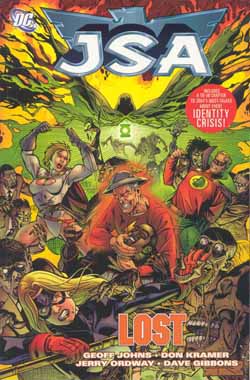 Â
Â